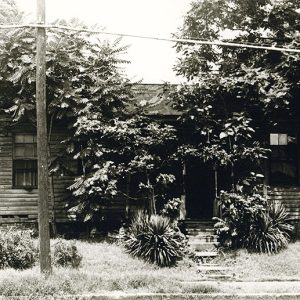calsfoundation@cals.org
McVicar House
The McVicar House is a one-story wooden structure in the heart of downtown Little Rock (Pulaski County). Originally on Lot 8 of Block 32 between the Brownlee House and the Hinderliter Grog Shop, the house was moved for aesthetic purposes to its current location on the grounds of what is now Historic Arkansas Museum during the 1939–1941 restoration by Louise Loughborough and Max Mayer.
On February 16, 1842, Thomas Thorn sold Lots 7, 8, and 9 on Block 32 to James McVicar for the sum of $4,000, even though Thorn had acquired the same lots at a public auction from Chester Ashley four years earlier for $128. Thorn was able to turn a substantial profit, thirty-one times his original investment, because Ashley charged him only what he was owed on the property by Jesse Hinderliter, who died in 1834.
Built by James McVicar sometime between 1846 and 1849, the McVicar House was constructed from white oak timber framing and square pegs. Like the Brownlee House, McVicar’s home follows a symmetrical 1840s style with a large central hall bordered by two rooms of equal size. It is a sophisticated version of the double-pen log house common to Arkansas during the time.
James McVicar moved to Little Rock in December 1837. Organized as McVicar and Company, James McVicar, Robert Brownlee, John Cooper, and Samuel McMorrin worked as stonemasons to construct Arkansas’s first state capitol, known today as the Old State House Museum. They were responsible for setting the stone foundations for the capitol building, which was finished by 1840. Afterward, McVicar took the position of warden of the Arkansas State Penitentiary. McVicar was also a Mason and held the title of Grand Master of the Grand Lodge of Arkansas.
In 1846, McVicar joined Colonel Archibald Yell’s Arkansas cavalry regiment and served as a quartermaster sergeant in the Mexican War. But McVicar and company were soon swept up in the gold rush. In 1849, McVicar led a band of men from Arkansas to California to join the gold rush. Though successful in California, as a property owner rather than as a gold miner, he returned to Little Rock in 1869. Before he died in 1872, McVicar sold the house and property to Richard Fletcher in 1869 for $3,500. The house remained a single-family dwelling through the rest of the nineteenth century.
In the early days of the Arkansas Territorial Restoration, Loughborough was eager to publicize the significance of the properties while also looking for donations from old Arkansas families. Though it was known James McVicar lived in this house, Louise Loughborugh added the claim that Governor Elias Conway also lived here. For years, it was called the Conway House, and the interior was furnished with items belonging to the Conway family. However, serious research into Block 32’s history in the 1980s led to the abandonment of the Conway name, and the home has since been interpreted during the period McVicar lived in the structure.
The McVicar House is part of the Arkansas Territorial Restoration District, which was listed on the National Register of Historic Places on May 31, 2019.
For additional information:
“Arkansas Territorial Restoration Historic District.” National Register of Historic Places registration form. On file at Arkansas Historic Preservation Program, Little Rock, Arkansas. Online at https://www.arkansasheritage.com/docs/default-source/national-registry/atrhd-pdf.pdf?sfvrsn=ba094ba1_0 (accessed June 25, 2021).
Bennett, Swannee. “An Interpretive Narrative and Furnishings Plan for the Arkansas Territorial Restoration Historic Structures.” Historic Arkansas Museum Archive, Little Rock, Arkansas.
Brownlee, Robert. An American Odyssey: The Autobiography of a 19th-Century Scotsman, Robert Brownlee, at the Request of His Children. Napa County, California, October 1892. Edited by Patricia A. Etter. Fayetteville: University of Arkansas Press, 1986.
Historic Arkansas Museum. http://www.historicarkansas.org/ (accessed June 25, 2021).
Worthen, William B. “Louise Loughborough and Her Campaign for ‘Courage and Fineness.’” Pulaski County Historical Review 40 (Summer 1992): 26–33.
———. “Restoring the Restoration.” History News 39 (November 1984): 6–11.
Victoria Chandler
Historic Arkansas Museum
 Historic Preservation
Historic Preservation Louisiana Purchase through Early Statehood, 1803 through 1860
Louisiana Purchase through Early Statehood, 1803 through 1860 McVicar House
McVicar House  McVicar House
McVicar House  McVicar House
McVicar House 




Comments
No comments on this entry yet.